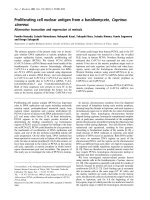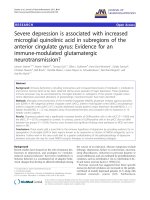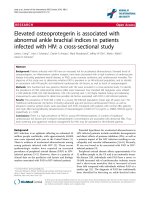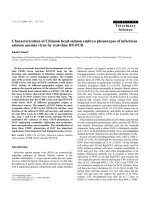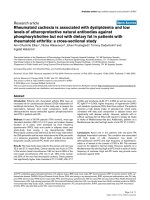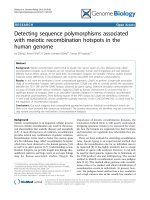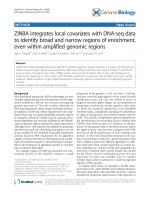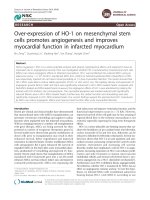Báo cáo y học: " Food assistance is associated with improved body mass index, food security and attendance at clinic in an HIV program in central Haiti: a prospective observational cohort study" docx
Bạn đang xem bản rút gọn của tài liệu. Xem và tải ngay bản đầy đủ của tài liệu tại đây (493.9 KB, 8 trang )
RESEARC H Open Access
Food assistance is associated with improved
body mass index, food security and attendance
at clinic in an HIV program in central Haiti:
a prospective observational cohort study
Louise C Ivers
1,2,3,4*†
, Yuchiao Chang
3,4†
, J Gregory Jerome
5†
, Kenneth A Freedberg
3,4†
Abstract
Background: Few data are available to guide programmatic solutions to the overlapping problems of
undernutrition and HIV infection. We evaluated the impact of food assistance on patient outcomes in a
comprehensive HIV program in central Haiti in a prospective observational cohort study.
Methods: Adults with HIV infection were eligible for monthly food rations if they had any one of: tuberculosis,
body mass index (BMI) <18.5kg/m
2
, CD4 cell count <350/mm
3
(in the prior 3 months) or severe socio-economic
conditions. A total of 600 individuals (300 eligible and 300 ineligible for food assistance) were interviewed before
rations were distributed, at 6 months and at 12 months. Data collected included demographics, BMI and food
insecurity score (range 0 - 20).
Results: At 6- and 12-month time-points, 488 and 340 subjects were eligible for analysis. Multivariable analysis
demonstrated that at 6 months, food security significantly improved in those who received food assistance versus
who did not (-3.55 vs -0.16; P < 0.0001); BMI decreased significantly less in the food assistance group than in the
non-food group (-0.20 vs -0.66; P = 0.020). At 12 months, food assistance was associated with improved food
security (-3.49 vs -1.89, P = 0.011) and BMI (0.22 vs -0.67, P = 0.036). Food assistance was associated with improved
adherence to monthly clinic visits at both 6 (P < 0.001) and 12 months (P = 0.033).
Conclusions: Food assistance was associated with improved food security, increased BMI, and improved adherence
to clinic visits at 6 and 12 months among people living with HIV in Haiti and should be pa rt of routine care where
HIV and food insecurity overlap.
Introduction
Food insecurity and undernutrition are increasingly
recognized as factors that are important in the health and
livelihoods of individuals living with HIV infection in
poor settings [1,2]. HIV infection has long been asso-
ciated with wasting syndrome and being underweight
with HIV is predictive of a poor prognosis, even in people
rece iving antiretroviral therapy (ART) [1,3-5]. Food inse-
curity–meaning lack of access to food of sufficient quality
and quantity to perform usual daily activities–contributes
to a negative cycle of events that often worsens the effect
of HIV infection on ability to work, attend school, contri-
bute to family livelihoods and adhere to medications
[6-8]. International organizations have called for food
assistance to be integrated into HIV treatment and pre-
vention programs, but evidence-based guidance on how
exactly to implement such programs, on what benefici-
aries to target, and on what the optimal components or
duration of food assistance should be is limited [9-14].
A recent study showed that food rations were associated
with improved adherence to ART, but thes e data did not
show any quantitative clinical benefit [15].
Attention to adequate nutrition during HIV care has the
potential to contribute to improved clinical HIV-related
* Correspondence:
† Contributed equally
1
Division of Global Health Equity, Brigham and Women’s Hospital, Boston,
Massachusetts, USA
Full list of author information is available at the end of the article
Ivers et al. AIDS Research and Therapy 2010, 7:33
/>© 2010 Ivers et al; lic ensee BioMed Central Ltd. Thi s is an Open Access article distribu ted under the terms of the Creativ e Commons
Attribution License ( which permits unrestricted use, distribution, and reproduction in
any medium, provided the original work is properly cited.
outcomes, improved nutritional outcomes fo r the indivi-
dual, as well as improved coping strategies and ability of
individuals to contribute to livelihoods at the household
level. Although the qualitative effect of food on relieving
hunger is not in doubt, the quantitative benefits of food
assistance on individuals or on families has rarely been
studied in the context of HIV [16]. As a result of political
instability, environmental degradation, poverty and recur-
rent natural disasters, Haiti is extremely vulnerable to food
insecurity. The aim of this study was to determine the
impact of targeted food assistance on the body mass index
(BMI), quality of life and household food security of peo-
ple living with HIV in a comprehensive health program in
central Haiti.
Methods
The stud y was a prospective observational cohort study
of 600 people living with H IV enrolled in HIV care in
Partners In Health (PIH) progra ms in rural Haiti. PIH is
a non-profit organization w orking in conjunction with
the Ministry of Health of Haiti to provide comprehen-
sive primary healthcare services, including HIV care, in
two departments in rural Haiti. In May 2006, PIH
enteredintocollaborationwiththeWorldFoodPro-
gramme (WFP) to provide food rations for beneficiaries
living w ith HIV. Because available rations were limited,
beneficiaries of the program were determined by a set of
criteria agreed upon in advance by WFP and PIH pro-
gram staff, includin g clinicians, social workers, and ethi-
cists. Adults received twelve months o f food assistance
if they had HIV and any one of: co-infection with ac tive
TB, CD4 count less than 350 cells/mm
3
in the prior
three months, BMI less than 18.5 or severe socioeco-
nomic circumstances (based on social worker assess-
ment and clinical team consensus). A standard
pre-dete rmined WFP family ration was provided by pre-
scription monthly. The ration contained 50 gm of cereal,
50 gm of dried legumes, 25 gm of vegetable oil, 100 gm
of corn-soya blend and 5 gm of iodized salt for each of
3 family members (approximately 949 kilocalories) per
person per day.
Three PIH clinic sites were included in the study (one
rural, one urban, one semi-urban). At each site the first
100 individual s eligible for food assistance and first 100
ineligible for foo d assistance by the criteria defined
above were invited to participate in the study. Indivi-
duals were eligible for interview if they were living with
HIV, were being assessed by the clinical team for elig-
ibility for the food program, were over the age o f 18
years and were not pregnant at the time of interview.
Combination ART is offered to those with HIV infec-
tion and CD4 counts less than 350 cells/mm
3
or with
World Health Organization clinical criteria to begin
treatment. Pregnant women are offered ART for their
own health when CD4 count is less than 350 cells/mm
3
or at 28 weeks of gestation for prevention of mother-to-
child transmission. Weight is measured routinely during
patient monthly visits to clinic. Height was measured
for adults at the beginning of the WFP collaboration
using a clinic-installed stadiometer to allow calculation
of BMI by clinic staff. In addition to medical care,
attention is paid to the socioeconomic causes and con-
tributors to disease and ill-health, and social assistance
programs make small grants for commerce or housing
repair available. All care is provided free of charge to
patients [17].
Surveys
Individuals were interviewed before rations were distrib-
uted and at 6 months and 12 months after food assis-
tance began. Data collected in surveys included
demographics, education level, BMI, food insecurity
score and quality of life. Additional information was
abstracted from the respondent’s electronic medical
record including CD4 count, timely attendance at pre-
scribed monthly clinic visits, weight, BMI and pick up of
prescribed food rations. Food insecurity score was mea-
sured using the Household Food Insecurity Access Scale
(HFIAS) [18]. In this scale (ranging from 0 for best food
security to 20 for worst), points are attributed for items
that relate to the availability of food in the household.
The authors had previously refined and a dapted this
questionnaire for use in rural Haiti using the methods
recommended by Coates et al [18,19]. Quality of life
was measured using role-functioning and performance-
functioning domains adapted from the AIDS Clinical
Trials Group SF-2, with scores ranging from 0 to 100
[20]. Instruments were translated into Haitian Creole
and b ack-translated to English for accuracy. Interviews
were performed by native Haitian Creole speakers. Data
were double-punch entered into MS Access database.
Ethics committee approval was received for the study
from the Zanmi Lasante (Partners In Health) Ethics
Committee in Haiti and by th e Institutional Review
Board at Brigham a nd Women’s Hospital, Boston, MA,
USA.
Analysis
Duration on ART was determined for each respondent
at the t ime of entry into the study and t he respondent
analyzed in this category throughout the study: ‘never
on ART’, ‘on ART < 12 months, ‘on ART ≥12 months’.
Active TB infection was an absolute indication for
receiving food assistance in the PIH program. Since no
active TB patient w ould be found in the ‘non-interven-
tion’ group, and because TB contributes to weight loss
indepen dent ly of HIV infection, subjects that had act ive
TBduringtheperiodofthestudywereexcludedfrom
Ivers et al. AIDS Research and Therapy 2010, 7:33
/>Page 2 of 8
the final analy sis. Subjects t hat were e ither enrolled in
or discontinued from food rations by the clinical team
during the period of the study were als o excluded from
the final analysis (’as-treated analysis’). Individuals were
also excluded from analysis if they became pregnant
during the study. BMI analysis was limited to those with
weight available (N = 4). We also performed a sensitivity
analysis using an ‘intention to treat’ ap proach, including
all subjects based on their enrollment status at the time
of baseline evaluation. For those with missing food
security items, the response was replaced by the median
value from all respondents in the same phase of the
study (i.e. baseline, 6 months or 12 months). We also
performed a sensitivity analysis using the E-M algorithm
to impute missing food security items at 6 and 12
months.
Baseline data were summarized u sing mean/standard
deviation (SD) or percentage and compared between the
‘no food assistance’ group and the ‘food assistance’
group using two-sample t-tests or Chi-square tests.
Continuous outcomes of change from baseline were
summarized using mean/standard error (SE). In the uni-
variate analysis, Wilcoxon rank sum tests were used to
compare continuous outco mes while repeated measures
logistic regression with Generalized Estimating Equa-
tions (GEEs) were used to compare dichotomized out-
comes. In the multivariable analysis, linear regression
and repeated measures logistic regression analysis were
used to compare the change from baseline between the
two groups controlling for other factors. All analyses
were performed using SAS version 9.2 (SAS Institute,
Cary, NC).
Results
Between May and July 2006, 600 adults were enrolled
across the three clinical sites. At 6- and 12-month fol-
low ups, 488 and 340 individuals were eligible for the
analysis (Figure 1).
Baseline Characteristics
The488adultsinthestudywhowereeligiblefor
6-month follow up had mean (SD) age of 36 years (10);
60% were female (Table 1). The majority of parti cipants
(71.7%) spent all or most of their monthly income on
food. At baseline, 148 (30.3%) were not on antiretroviral
therapy (ART), 279 (57.2%) had been on ART for ≥12
months, and 61 (12.5%) had been on ART for <12
months. At baseline, compared to the group that did
receive food assistance, the group receiving no food
assistance contained fewer individuals on ART [N = 145
(57.8%) vs. N = 195 (82.3%), P < 0.0001], had better
food security (13.9 vs. 15.4, P < 0.0001), had higher BMI
(22.4 vs. 20.4, P < 0.0001) and had more individuals
sharing household meals on average (6.7 vs.6.1,
P = 0.035). Similar patterns persisted in the assessment
of the 340 subjects eligible for 12-month follow up.
Food Insecurity and Body Mass Index
In univariate analysis at 6 and 12 months, food security
was improved in the group that re ceived food compared
to the non-food group (Table 2). On a scale of 0 (best)
to 20 (worst), mean change (SD) in food insecurity
score in the food assistance group was -3.55 compared
to -0.16 in the non-food group at 6 months (P < 0.0001)
and -3.49 compared to -1.89 at 12 months (P = 0.011).
At 6 months, BMI decreased in both groups, but fell
less in the food assistance group compared to the non-
food group (-0.20 vs. -0.66, P = 0.012). At 12 m onths,
BMI increased in the food group and decreased in the
non-food group (+0.22 vs. -0.67, P = 0.002).
Adherence to clinic visits and medications
At both 6 and 12 months, timely attendance at monthly
clinic visits was better in the food assistance group than
in the non-food group. The mean number of scheduled
visits attended at 6 months (out of 6 visits) was 5.49 vs.
2.82 (P < 0.0001) for the food assistance vs. the non-
food group, and at 12 months (out of 12 visits) was 9.73
vs. 8.34 (P = 0.007).
Quality of life
There was no statistical difference in role-functioning
qualityoflife(QOL)betweenthegroupsat6months.
At 12 months, mean role-functioning QOL score
increased in the food assistance group (3.72) and
decreased in the non-food group (-3.80), however the
difference did not reach significance level (P = 0.13).
Performance-functioning QOL had a slightly greater
increase at 6 months in the food assistance group com-
pared to the non-food group ( mean change 10.69 vs.
5.31, P = 0.055). There was no difference at 12 months
between the two groups (8.76 vs.9.47, P = 0.48).
Among those on ART, at 6 months, those receiving
food assistance reported fewer difficulties taking their
medications compared to those who did not receiv e
food (14.4% vs. 28.1%, P = 0.001). At 12 months,
although a difference remained betwe en the groups
(11.0% vs. 18.8%), it di d not reach statistical significance
level (P = 0.068). There were no significant d ifferences
between groups at either 6 or 12 months in terms o f
ability to save money in case of disaster, spending on
agriculture or education, or spending on livestock.
There was also no statistical difference in outcomes of
died or abandoned care at 6 or 12 months.
There were 129 individuals who changed from the
non-food group to the food assistance group during the
course of the study. Most (N = 121) of these changes
occurred during the second half of the study in the
Ivers et al. AIDS Research and Therapy 2010, 7:33
/>Page 3 of 8
Figure 1 Distribution of subjects with HIV enrolled in observational cohort study in central Haiti. TB = tuberculosis. BMI = body mass
index. * not mutually exclusive. ** all changes in food status were from “No Food” to “Food Assistance” status. ¶ 1 subject did not have BMI
data and was not included in BMI analysis. ¶¶ 3 subjects did not have BMI data and were not included in BMI analysis
Table 1 Baseline characteristics at 6 and 12 months of a cohort of people with HIV in central Haiti
Subjects with 6-month follow-up Subjects with 12-month follow-up
No Food
group
(N = 251)
Food Assistance
group
(N = 237)
P value No Food
group
(N = 125)
Food Assistance
group
(N = 215)
P value
Age, mean yrs (SD) 35 (9) 37 (10) 0.12 36 (10) 37 (10) 0.26
Female, N (%) 149 59.4% 144 60.8% 0.75 74 59.2% 126 58.6% 0.91
Proportion of monthly income spent on food*, N (%) 0.80 0.68
None 22 8.8% 28 11.8% _ 10 8.0% 25 11.6% _
Small amount 13 5.2% 10 4.2% _ 7 5.6% 8 3.7% _
Half 28 11.2% 29 12.2% _ 13 10.4% 27 12.6% _
Most 72 28.7% 65 27.4% _ 38 30.4% 58 27.0% _
All 112 44.6% 101 42.6% _ 55 44.0% 94 43.7% _
ART group, N (%) <0.0001 <0.0001
No ART 106 42.2% 42 17.7% _ 47 37.6% 40 18.6% _
On ART ≥ 1 yr 134 53.4% 145 61.2% _ 69 55.2% 130 60.5% _
On ART < 1 yr 11 4.4% 50 21.1% _ 9 7.2% 45 20.9% _
Female-headed household*, N (%) 123 49.0% 112 47.3% 0.67 63 50.4% 102 47.4% 0.58
Literate*, N (%) 148 59.0% 127 53.6% 0.25 75 60.0% 119 55.3% 0.43
Number sharing household meals, mean (SD) 6.7 (2.9) 6.1 (2.9) 0.035 6.8 (2.9) 6.3 (2.9) 0.18
Food insecurity score**, mean (SD) 13.9 (3.9) 15.4 (3.9) <0.0001 14.0 (4.1) 15.3 (3.9) 0.003
Body mass index†, mean kg/m
2
(SD) 22.4 (2.7) 20.4 (3.2) <0.0001 22.5 (3.0) 20.2 (3.0) <0.0001
SD = standard deviation
ART = antiretroviral therapy
* sample size varies due to missing survey responses
** range 0 (best food security) to 20 (worst food insecurity
† Body mass index range: ≤18.5 = underweight; 18.5-24.9 = normal; ≥25.0 = overweight
Ivers et al. AIDS Research and Therapy 2010, 7:33
/>Page 4 of 8
6-to-12-month period that coincided with the ‘lean sea-
son’ in Haiti. It is possible that individual’s socioeco-
nomic s tatus worsened during this time, prompting the
team to en roll individuals in food assistance based on
these criteria. In addition, as the program timeline p ro-
gressed, rations that h ad not yet been assigned within
the total number of p rogram rations available may have
prompted an informal relaxation of the socioeconomic
criteria for eligibility. Of the 129 individuals that
switched status from ‘no food assistance’ to ‘food assis-
tance’, seven had BMI < 18.5 and eight had CD4 count
< 350 cells/mm
3
at the 6-month evaluation; one had TB
and 12 were pregnant at the 12-month survey. When
compared to the 125 individuals t hat did not change
status from ‘no food’ to ‘food assistance’,theyhad
slightly less improvement in food security (-0.10 vs.
-0.20) and slightly worse BMI (-0.72 vs. -0.61) at 6
months, but neither was significant (P = 0.81, P = 0.97).
These individuals we re excluded from the final analysis
(Figure 1).
Multivariable analysis
In establishing the multiple regression analysis model we
used existing literature, including the conceptual frame-
work o f Egge et al [1,2,8,21] to establish factors of
importance a pr iori. We also accounted for the baseline
differences between the two groups. The final model
compared the two groups controlling for gender, lit-
eracy, ART group and number of people sharing meals
in the household. At both 6 and 12 months, food assis-
tance was associated with better food securi ty
(P < 0.0001 and P = 0.011), improved BMI (P = 0.020,
P = 0.036), better adherence to monthly clinic visits
(P < 0.0001, P = 0.033) compared to no food assistance.
A sensitivity analysis including all patients with tubercu-
losis did not change the outcome of the study.
Discussion
This study finds that providing food assistance to indivi-
duals with HIV and food inse curity in central Haiti
improves BMI, food security and adherence to clinic
Table 2 6-month and 12-month outcomes among a cohort of people living with HIV in Haiti who did and did not
receive food assistance
6-month outcomes 12-month outcomes
No food
group
(N = 251)
Food
Assistance
group
(N = 237)
Univariate
P value
Multivariable
P value*
No food
group
(N = 125)
Food
Assistance
group
(N = 122)
Univariate
P value
Multivariable
P value*
Change in Food Insecurity
Score, mean (SE)
-0.16 (0.28) -3.55 (0.33) <0.0001 <0.0001 -1.89 (0.47) -3.49 (0.33) 0.011 0.011
Change in body mass index**,
mean (SE)
-0.66 (0.13) -0.20 (0.13) 0.012 0.020 -0.67 (0.22) 0.22 (0.17) 0.002 0.036
Adherence to scheduled
monthly clinic visits, mean
number attended (SE)
2.82 (0.20) 5.49 (0.17) <0.0001 <0.0001 8.34 (0.44) 9.73 (0.32) 0.007 0.033
Change in QOL (role-
functioning), mean (SE)
-5.08 (3.01) -1.90 (2.98) 0.28 0.84 -3.80 (4.03) 3.72 (3.46) 0.13 0.11
Change in QOL (performance-
functioning), mean (SE)
5.31 (1.77) 10.69 (1.99) 0.055 0.009 9.47 (2.67) 8.76 (2.17) 0.48 0.69
Reports problem taking ART
†
,N
(%)
41 28.1% 26 14.4% 0.001 0.001 15 18.8% 18 11.0% 0.068 0.075
Was able to save money in
case of disaster**, N (%)
66 26.5% 45 19.1% 0.63 0.35 41 33.3% 52 24.9% 0.59 0.42
Spent less money on
agriculture to buy food**, N (%)
75 38.1% 57 31.7% 0.58 0.57 37 39.8% 48 25.9% 0.11 0.082
Spent less on education to buy
food**, N (%)
84 36.5% 75 33.9% 0.75 0.63 34 30.6% 68 33.7% 0.28 0.25
Sold livestock to buy food
‡
,N
(%)
43 41.3% 25 24.5% 0.092 0.082 20 38.5% 25 25.0% 0.097 0.11
SE = standard error
ART = antiretroviral therapy
QOL = quality of life
* Controlling for gender, literacy, ART group, number of people sharing meals in the househo ld
** Sample size varied due to missing survey responses
†
Limited to those who were on ART
‡
Limited to those who owned livestock
Ivers et al. AIDS Research and Therapy 2010, 7:33
/>Page 5 of 8
visits. We also observed a significant improvement in
ability to take ART at 6 months and a trend for
improvement in t his variable at 12 months. Although
many studies have evaluated the impact of micronutri-
ent supplementation on HIV disease progression, to our
knowledge, this is the first study demonstrating a quan-
titative clinical benefit of macronutrient supplementa-
tion on HIV clinical outcomes.
Low BMI may result from chronic inadequate food
intake, wasting as a result of HIV or other infections, or
in some individuals may be a normal anthropometric
variation. Low BMI has previously been independently
associated with poor outcomes among individuals with
HIV infection even while on ART [22-24]. In this study,
after 6 months, there was a dec rease in BMI in both
groups, although the group not receiving food assistance
had significantly greater decrease in their BMI. At
12 months, loss in body mass persisted in the no food
ass istance group, but BMI had increased significantly in
the group receiving food assistance. The 6-month eva-
luation was conducted during the dry season, which is
the typical ‘lean season’ in central Haiti, with food
usually more scarce. It is likely that this contributed to
both groups losing weight at that time.
Of note, the pre-determined WFP ration distributed to
support people living with HIV in Haiti provides
approximately 45% of the caloric requirement of a
family of three, although the median number o f people
eating at the households in this study was six. Further-
more, the ration is not targeted specifically to indivi-
duals with HIV infection, but is rather a fami ly support.
Despite these issues, that by virtue of quantity and qual-
ity might be expected to attenuate the effect of food
support on the individuals we studied, food rations were
protective against weight loss in the short-term and
associated with weight gain in the long-term for the
individuals with HIV.
Seventy-two percent of the participants in this study
spent most or all of their income on food and mean
baseline food insecurity wasveryhigh(14.6onascale
of 0 to 20). This is consistent with national statistics for
the region [25]. In our study, food rations for people liv-
ing with HIV were associated with significant improve-
ments in food security at both 6 and 12 months. In
addition to relief of anxiety regarding food availability,
the programmatic i mportance of improving food secur-
ity can be considered in terms of its effects on general
health, nutrition, HIV infection and health services
usage. The negative interactions between food insecurity
and HIV are well known [5,8,26-28]. In Canada food
insecurity was a risk factor for mortality among indivi-
duals with HIV on ART, particularly when this was
associated with being underweight [29]. Food insecurity
was also associated with incomplete viral suppression
among HIV-infected urban poor in San Francisco [30].
In non-HIV infected individuals, food insecurity has
been associated with self-reported poor health and
depressive symptoms [31], with postponing needed med-
ical care and high rates of emergenc y department usage
[32] and as a strong predictor of symptoms of anxiety
and depression [33]. In Haiti, household food insecurity
has recently been associated with childhood malaria
[34]. Interventions that result in quantitative improve-
ments in food security, as found in our study, have
potentially broad-reaching implications for the health of
people living with HIV.
This c urrent study also found that individuals re ceiv-
ing food assistance were significantly more likely to
attend scheduled clinic visits than those not receiving
food assistance. Los s to follow up of individuals not yet
on ART, and those on ART, is a critical challenge to
HIV care in resource-poor countries. Studies have
shown early loss to follow up of as many as 21% of indi-
viduals newly started on ART at 6 months [35,36]. In a
fee-fo r-service clinic in urban South Africa, 16% of indi-
viduals eligible for ART were lost to follow up even
before ART could be started [37]. In our program, peo-
ple living with HIV are provided a transportation sti-
pend to attend monthly clinic visits. This is intended to
offset their opp ortunity costs for the visit, thus encoura-
ging attendance and, along with a comprehensive pack-
age of services free of charge to patients, contributes to
an improved level of attendance and a very low rate of
loss to follow up over time [38]. Despite the already
good baseline attendance, however, we found that food
assistance is an important factor i n keeping food inse-
cure individuals with HIV infection engaged in care.
Lack of sufficient food in the diet has further negative
effects on HIV care by impacting a bility to take antire-
troviral medications in a number of ways, including
causing symptoms of nausea while taking medications
on an empty stomach, increasing drug toxicity, and/or
forcing competing choices betwe en expenditures on
food and t ransportation or other health-related needs.
Cantrellandcolleaguesdemonstratedthatfoodsupple-
mentation was associated with improved adherence to
ART in an HIV clinic in Zambia [15], but that study
failed to demonstrate a direct benefit of the food supple-
ment on clinical outcomes–potentially because of lack of
power to detect a difference. This study found that food
assistance was associated with fewer difficulties in taking
medications. This finding was statistically significant at
6 months, but not at 12 months, although the 12-month
trend was towards a benefit of food assistance. T his is
an importan t finding, given that very high l evels of
adherence to ART are necessary for viral suppression
and the subsequent benefits of ART on the health of
individuals with HIV, and that adherence to ART is a
Ivers et al. AIDS Research and Therapy 2010, 7:33
/>Page 6 of 8
powerful predictor of survival among people living with
HIV [36].
HIV program managers had flexibility to enroll indivi-
duals in food assistance throughout the period of this
study because the study was observational. This hap-
pened in particula r between months 6 and 12 of the
study as WFP made an increased number of rations avail-
able and evaluation o f socioeconomic status became
more inclusive. In order to examine the food rations
effect in an “uncontaminated” fashion, we focused our
analysis on comparing the group of subjects that were eli-
gible for and remained in the food assistance program
from baseline to the group of subjects that were never
eligible for food assistance. Subjects not receiving rations
at baseline but who were enrolled for rations during the
study (and vice versa) were excluded from the analysis
(’as-treated’ analysis). We also performed a sensitivity
analysis that was ‘intention to treat’, including subjects
based on their enrollment status at the time of baseline
evaluation. This analysis demonstrated that at 6 and
12 months food assistance was associated with improve-
ments in food security (P < 0.001 and P = 0.03) and bet-
ter adherence to clini c visits (P < 0.0001 and P < 0.0001)
compared to no food assistance. There were trends
towards difference in BMI similar to those found in the
as-treated analysis, but these did not have statistical sig-
nificance (P = 0.07 and P = 0.16). A further sensitivity
analysis was performed using an alternate method for
imputing missing data. Using the E-M algorithm at 6 and
12 months [39], food assistance was associated with bet-
ter BMI (P = 0.020 and P = 0.036) and better adherence
to clinic visits (P < 0 .0001 and P = 0.03) compared to no
food assistance. Food security was better at 6 months
(P = 0.003) in the food assistance group compared to the
no food group. At 12 months there was a trend for
improvement in food security, but this was not significant
(P = 0.12). The E-M method of imputation reflects the
uncertainty of missing data and increases variabili ty com-
pared to using median va lues, thereby likely reduced
power to detect differences in the data[39].
Study Limitations
The study has several limitations. It was an observational
study and subjects were not randomly selected to receive
the intervention. We attempted to control for measured
differences between the groups using multivariable analy-
sis however other factors not controlled in the analysis
may have influenced the associations among food secur-
ity, food assistance and other outcomes. With regards to
unmeasured bias, subjects in the intervention group were
‘worse- off’ or ‘more vulnerable’ than the subjects in the
control group by virtue of the design of the food assis-
tance program, which aims to help those that are consid-
ere d the most vulnerable. The food assistance group had
lower weight, higher food insecurity and was more likely
to be on ART than the no food assistance group before
the study began and may have had other unmeasured dif-
ferences that could have systematically influenced the
outcome. Since those that are ‘more vulnerable’ may be
expected to do worse over the course of 12 months than
those in the ‘less vulnerable’ control group, we believe
that the differences at baseline would have biased the
study result to the null. If the effect we had observed was
simply a phenomenon of “regression toward the mean,”
we would have expected the food insecurity score to be
quite similar between the two groups at follow-ups. How-
ever, the food insecurity score was lower in the food
group than the non-food group at both follow-up times
(8.94 vs. 9.65 at 6 months and 8.95 vs. 9.16 at 1 2
months); therefore, the effect cannot be simply explained
by regression to the mean. The fact that our study found
significant differences in outcomes, despite non-randomi-
zation of the intervention, su ggests that the effect of the
intervention is real.
Conclusions
This study demonstrates that food assistance is asso-
ciated with improvements in clinical outcomes among
people with HIV infection and food insecurity in central
Haiti. Food assistance as part of comprehensive health-
care is associated with significant improvements in BMI,
food security, and adherence to clinic visits at 6 and
12 months among people living with HIV. Food assis-
tance should be standard of care in regions where HIV
and food insecurity overlap.
Abbreviations and Acronyms
ART: antiretroviral therapy; BMI: body mass index; HFIAS: Household Food
Insecurity Access Scale; HIV: human immunodeficiency virus; PIH: Partners In
Health; QOL: quality of life; TB: tuberculosis; SD: standard deviation; WFP:
World Food Programme
Competing interests
The authors declare that they have no competing interests.
Authors’ contributions
LCI, KAF and JGJ contributed to the design of the study, analysis of the data
and to writing the manuscript. YC contributed to analysis of data and
writing of the manuscript. All authors read and approved the final
manuscript.
Acknowledgements
Sources of Support for Study
This work was supported in part by National Institute of Allergy and
Infectious Disease (K23 AI063998 to LCI; K24 AI062476 to KAF), by the
Harvard Center for AIDS Research (P30 AI060354-02S1) and by the Johnson
and Johnson Foundation.
Author details
1
Division of Global Health Equity, Brigham and Women’s Hospital, Boston,
Massachusetts, USA.
2
Partners In Health, Boston, Massachusetts, USA.
3
Biostatistics and Computational Biology, Harvard University Center for AIDS
Research, Cambridge, Massachusetts, USA.
4
General Medicine Division,
Ivers et al. AIDS Research and Therapy 2010, 7:33
/>Page 7 of 8
Massachusetts General Hospital, Boston, Massachusetts, USA.
5
Zanmi Lasante,
Cange, Haiti.
Received: 4 May 2010 Accepted: 26 August 2010
Published: 26 August 2010
References
1. Gillespie S, Kadiyala S: HIV/AIDS and food and nutrition security: from
evidence to action. Washington, D.C.: International Food Policy Research
Institute (IFPRI) 2005, Report No.: Food Policy Review 7.
2. Ivers LC, Cullen KA, Freedberg KA, Block S, Coates J, Webb P: HIV/AIDS,
undernutrition, and food insecurity. Clin Infect Dis 2009, 49(7):1096-102.
3. Campa A, Yang Z, Lai S, et al: HIV-related wasting in HIV-infected drug
users in the era of highly active antiretroviral therapy. Clin Infect Dis
2005, 41(8):1179-85.
4. Piwoz E, Preble E: HIV/AIDS and nutrition: a review of literature and
recommendations for nutritional care and support in sub-Saharan Africa.
Washington, D.C.: Academy for Educational Development 2000.
5. Mangili A, Murman DH, Zampini AM, Wanke CA: Nutrition and HIV
infection: review of weight loss and wasting in the era of highly active
antiretroviral therapy from the Nutrition for Healthy Living cohort. Clin
Infect Dis 2006, 42(6):836-42.
6. Food insecurtiy and hunger in the United States: an assessment of the
measure. Washington, DC: National Research Council 2006.
7. Marston B, De Cock K: Multivitamins, nutrition, and antiretroviral therapy
for HIV disease in Africa. NEngJMed2004, 351:78-80.
8. Haddad L, Gillespie S: Effective food and nutrition policy responses to
HIV/AIDS: what we know and what we need to know. J Int Dev 2001,
13(4):487-511.
9. Anema A, Vogenthaler N, Frongillo EA, Kadiyala S, Weiser SD: Food
insecurity and HIV/AIDS: current knowledge, gaps, and research
priorities. Curr HIV/AIDS Rep 2009, 6(4):224-31.
10. United States Agency for International Development (USAID): A
Wholesome Approach: Nutrition and HIV/AIDS. [ />our_work/global_health/aids/TechAreas/caresupport/nutrition.html],
Accessed 2010 March 16.
11. World Health Organization: WHO Nutrition: Nurturing Health. Regional
Consultation on Nutrition and HIV/AIDS in French speaking countries in
Africa Region: Evidence, lessons and recommendations for action.
Ouagadougou, Burkina Faso. 2008.
12. Report on food and nutrition for people living with HIV/AIDS.
Washington, D.C.: The President’s Emergency Plan for AIDS Relief (PEPFAR)
2006.
13. World Food Programme, World Health Organization, UNAIDS: Policy Brief:
HIV, Food Security and Nutrition. Geneva. 2008.
14. The World Bank: Repositioning nutrition as central to development: A
strategy for large-scale action. Washington, D.C.: The World Bank 2006.
15. Cantrell RA, Sinkala M, Megazinni K, et al: A pilot study of food
supplementation to improve adherence to antiretroviral therapy among
food-insecure adults in Lusaka, Zambia. J Acquir Immune Defic Syndr 2008,
49(2):190-5.
16. Koethe J, Chi BH, Megazinni KM, Heimburger DC, Stringer JS:
Macronutrient supplementation for malnourished HIV-infected adults: a
review of the evidence in resource-adequate and resource-constrained
settings. Clin Infect Dis 2009, 29:787-98.
17. Mukherjee J: The PIH Guide to the Community-Based Treatment of HIV
in Resource-Poor Settings. Boston, MA: Partners In Health, 2 2006.
18. Coates J, Swindale A, Bilinsky P: Household Food Insecurity Access Scale
(HFIAS) for Measurement of Food Access: Indicator Guide. Washington,
D.C.: Food and Nutrition Technical Assistance Project (FANTA), Academy for
Educational Development 2007.
19. Ivers LC, Jerome JG, LoPorto K, Smith Fawzi MK, Mukherjee JS: Pervasive
food insecurity is a major factor in the care of patients with HIV
infection in resource-poor settings. XVI International AIDS Conference.
Toronto 2006.
20. Wu A: ACTG QOL602 Health Survey Manual: Adult AIDS Clinical Trials
Group. [ />manualql601-2799.pdf], Accessed 2010 March 16.
21. Stokes SC: Measuring Impacts of HIV/AIDS on Rural Livelihoods and Food
Security. Sustainable Development Department Dimensions 2003.
22. Stringer JS, Zulu I, Levy J, et al: Rapid scale-up of antiretroviral therapy at
primary care sites in Zambia: feasibility and early outcomes. JAMA 2006,
296(7):782-94.
23. Zachariah R, Fitzgerald M, Massaquoi M, et al: Risk factors for high early
mortality in patients on antiretroviral treatment in a rural district of
Malawi. AIDS 2006, 20:2355-60.
24. Delfraissy JF: New French guidelines for antiretroviral treatment. HIV Med
2000, 1(3):133-6.
25. Coordination Nationale de la Sécurité Alimentaire: Indicateurs de la
sécurité alimentaire et indicateurs connexes. [ />statistiques.htm], Accessed 2010 March 16.
26. Katona P, Katona-Apte J: The interaction between nutrition and infection.
Clin Infect Dis 2008, 46(10):1582-8.
27. Piwoz E: Nutrition and HIV/AIDS: evidence, gaps and priority actions.
Washington, D.C.: Academy for Educational Development (AED) 2004.
28. Weiser SD, Leiter K, Bangsberg DR, et al: Food insufficiency is associated
with high-risk sexual behavior among women in Botswana and
Swaziland. PLoS Med 2007, 4(10):1589-97.
29. Weiser S, Fernandes K, Brandson E, et al: The association between food
insecurity and mortality among HIV-infected individuals on HAART.
J Acquir Immune Defic Syndr 2009, 52(3):342-9.
30. Weiser SD, Frongillo EA, Ragland K, Hogg RS, Riley ED, Bangsberg DR: Food
insecurity is associated with incomplete HIV RNA suppression among
homeless and marginally housed HIV-infected individuals in San
Francisco. J Gen Intern Med 2009, 24(1):14-20.
31. Che J, Chen J: Food insecurity in Canadian households. Health Rep 2001,
12(4):11-22.
32. Kushel M, Gupta R, Gee L, Haas J: Housing instability and food insecurity
as barriers to health care among low-income Americans. J Gen Intern
Med 2006, 21:71-7.
33. Hadley C, Patil C: Seasonal changes in household food insecurty and
symptoms of anxiety and depression. Am J Phys Anthropol 2008,
135(2):225-32.
34. Perez-Escamilla R, Dessalines M, Finnigan M, Pachon H, Hromi-Fiedler A,
Gupta N: Household food insecurity is associated with childhood malaria
in rural Haiti. J Nutr 2009, 139:2132-8.
35. Brinkhof M, Dabis F, Myer L, et al: Early loss of HIV-infected patients on
potent antretroviral therapy programmes in lower-income countries. Bull
World Health Organ 2008, 86:559-67.
36. Mills E, Nachega J, Buchan I, et al: Adherence to antiretroviral therapy in
Sub-Saharan Africa and North America: a meta-analysis. JAMA 2006,
296(6):679-90.
37. Bassett I, Wang B, Chetty S, et al: Loss to care and death before
antiretroviral therapy in Durban, South Africa. J Acquir Immune Defic
Syndr 2009, 51(2):135-9.
38. Mukherjee JS, Farmer PE, Ivers LC, et al: The intersection of access and
adherence–improving retention in HIV programs in resource poor
settings. XVII International AIDS Conference. Mexico City, Mexico 2008.
39. Allison PD: Missing Data. Sage Publications 2001.
doi:10.1186/1742-6405-7-33
Cite this article as: Ivers et al.: Food assistance is associated with
improved body mass index, food security and attendance at clinic in an
HIV program in central Haiti: a prospective observational cohort study.
AIDS Research and Therapy 2010 7:33.
Submit your next manuscript to BioMed Central
and take full advantage of:
• Convenient online submission
• Thorough peer review
• No space constraints or color figure charges
• Immediate publication on acceptance
• Inclusion in PubMed, CAS, Scopus and Google Scholar
• Research which is freely available for redistribution
Submit your manuscript at
www.biomedcentral.com/submit
Ivers et al. AIDS Research and Therapy 2010, 7:33
/>Page 8 of 8

